Canyons are deep‚ narrow valleys carved by rivers‚ showcasing stunning geological formations and diverse ecosystems. These natural wonders offer breathtaking landscapes and serve as vital cultural and historical landmarks.
1.1 What Are Canyons?
Canyons are deep‚ narrow valleys carved by rivers over millions of years‚ featuring steep cliffs and dramatic landscapes. They are formed through erosion‚ where water flows cut into rock layers‚ revealing geological history. Canyons vary in size and depth‚ from small gorges to massive formations like the Grand Canyon. These natural wonders often serve as habitats for unique flora and fauna‚ making them ecosystems of great biodiversity and scientific interest.
1.2 Importance of Canyons in Nature and Culture
Canyons hold immense ecological and cultural significance. They provide habitats for unique flora and fauna‚ supporting biodiversity. Culturally‚ canyons are sacred to indigenous communities‚ offering spiritual and historical connections. They also attract tourists‚ boosting local economies through hiking‚ photography‚ and adventure sports. Additionally‚ canyons serve as natural water sources and geological repositories‚ preserving Earth’s history. Their grandeur inspires artistic expression‚ making them invaluable natural and cultural treasures.

Popular Canyons Around the World
Canyons are awe-inspiring natural wonders found worldwide‚ each with unique geological features. The Grand Canyon‚ Fish River Canyon‚ and Yarlung Tsangpo Grand Canyon are among the most renowned‚ attracting millions for their breathtaking landscapes and diverse ecosystems.
2.1 The Grand Canyon‚ USA
The Grand Canyon‚ located in Arizona‚ is one of Earth’s most iconic natural wonders. Carved by the Colorado River over millions of years‚ it stretches 277 miles long‚ up to 18 miles wide‚ and a mile deep. Renowned for its layered rock formations‚ it reveals geological history. A UNESCO World Heritage Site‚ it attracts millions annually for hiking‚ camping‚ and rafting. Its sheer scale and vibrant colors make it a must-visit destination for adventurers and nature enthusiasts alike.
2.2 Fish River Canyon‚ Namibia
Fish River Canyon‚ located in southern Namibia‚ is one of the largest canyons in the world. Stretching over 100 miles long‚ 16 miles wide‚ and reaching depths of 2‚600 feet‚ it is a breathtaking natural wonder. Carved by the Fish River‚ Namibia’s longest river‚ the canyon offers dramatic vistas and rugged terrain. Its unique landscape‚ shaped by millions of years of erosion‚ attracts adventurers for hiking and scenic drives. The canyon’s remote location adds to its allure as a pristine wilderness destination.
2.3 Yarlung Tsangpo Grand Canyon‚ Tibet
Yarlung Tsangpo Grand Canyon‚ in Tibet‚ is the deepest canyon globally‚ with depths exceeding 17‚000 feet. Carved by the Yarlung Tsangpo River‚ it stretches over 308 miles. The canyon’s extreme depth and remote location make it a challenging yet breathtaking destination. Its dramatic cliffs and lush valleys‚ surrounded by the Himalayas‚ create a unique landscape. It’s a hotspot for geological research and adventure‚ offering insights into Earth’s formation and diverse ecosystems‚ despite its inaccessibility.
Planning Your Canyon Visit
Planning a canyon visit involves thorough research‚ obtaining necessary permits‚ and understanding regulations. Choose a canyon suited to your experience and physical condition. Consider the best time to visit for optimal weather and trail conditions. Proper preparation ensures a safe and enjoyable adventure.
3.1 Choosing the Right Canyon for Your Adventure
Choosing the right canyon depends on your experience level and preferences. Consider popular destinations like the Grand Canyon for iconic views or Fish River Canyon for remote adventures. Assess the difficulty‚ duration‚ and physical demands of trails. Research permits‚ accessibility‚ and weather conditions. For beginners‚ smaller canyons with well-marked paths are ideal‚ while experienced explorers may seek more challenging‚ less-traveled routes. Match your skills and interests to ensure a rewarding experience.
3.2 Best Time to Visit Canyons
The best time to visit canyons varies by location and climate. Spring and fall are ideal for most canyons‚ offering mild temperatures and vibrant scenery. Summer can be hot‚ especially in desert canyons‚ but it’s perfect for rafting and hiking in cooler regions. Winters may limit access due to snow but offer serene landscapes and fewer crowds. Plan according to your activity preferences and check local weather conditions to ensure a safe and enjoyable experience.
3.3 Necessary Permits and Regulations
Visiting canyons often requires permits to ensure conservation and safety. Backcountry permits are essential for overnight stays‚ while day-use permits may be needed for certain trails. Commercial activities‚ like guided tours‚ require special licenses. Regulations vary by location‚ so check local authorities for specific rules. Respect wildlife‚ avoid littering‚ and stay on designated paths to preserve these natural wonders. Failure to comply may result in fines or access restrictions‚ so plan accordingly and follow guidelines carefully.
Safety Guidelines for Canyon Exploration
Exploring canyons requires careful preparation and awareness of potential risks. Stay informed about terrain‚ weather‚ and necessary safety protocols to ensure a secure adventure.
4.1 Understanding Canyon Terrain and Hazards
Canyons feature steep cliffs‚ unstable rocks‚ and fast-flowing rivers. Flash floods‚ loose terrain‚ and extreme weather are common hazards. Recognizing these risks is crucial for safe exploration and navigation.
4.2 Essential Safety Gear and Equipment
Sturdy hiking boots‚ helmets‚ and ropes are vital for canyon exploration. Bring a first aid kit‚ headlamp‚ and navigation tools like maps and GPS devices. Carabiners and harnesses are essential for climbing‚ while hydration packs and sunscreen protect against dehydration and UV exposure. Always carry emergency supplies‚ including a whistle and multi-tool‚ to ensure preparedness for unexpected situations.
4.3 Emergency Preparedness and First Aid
Always carry a first aid kit tailored for canyon emergencies‚ including bandages‚ antiseptic wipes‚ and pain relievers. Pack a headlamp‚ emergency shelter‚ and a whistle for signaling help. Stay informed about weather conditions to avoid flash floods. Know basic first aid techniques for injuries like sprains or cuts. Carry a personal locator beacon (PLB) in remote areas with no cell service. Ensure someone knows your itinerary and expected return time for timely assistance in case of emergencies.
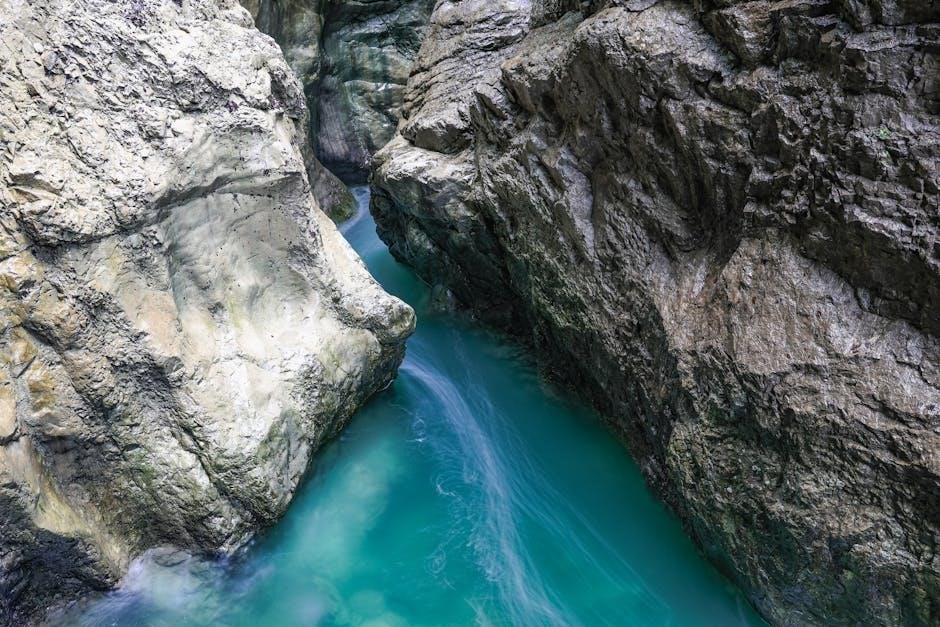
Hiking in Canyons
Hiking in canyons offers breathtaking adventures through stunning landscapes and unique trails. Plan carefully‚ stay prepared‚ and consider physical fitness and navigation skills for a successful hike.
5.1 Popular Hiking Trails in Famous Canyons
Iconic trails like the Bright Angel and South Kaibab in the Grand Canyon offer unforgettable views. The Inca Trail leads to Machu Picchu‚ blending history with nature. Fish River Canyon’s trails showcase Namibia’s rugged beauty‚ while the GR 10 in France spans across diverse landscapes. Each trail provides unique experiences‚ from challenging terrains to breathtaking vistas‚ attracting adventurers worldwide. Plan carefully‚ secure permits‚ and prioritize safety for a memorable hiking journey in these natural wonders.
5.2 Tips for Successful Canyon Hikes
- Plan according to your fitness level and experience‚ choosing trails that match your abilities. Always check weather forecasts to avoid unexpected conditions.
- Pack essentials like water‚ snacks‚ a map‚ and sunscreen. Stay hydrated‚ as canyon climates can be harsh and dry.
- Wear sturdy footwear and layers for changing temperatures. Bring a first aid kit and emergency shelter‚ just in case.
- Respect the environment—leave no trace. Inform someone of your route and expected return time for safety.
5.3 Navigation and Map Reading Skills
- Mastering navigation is crucial for canyon hikes. Always carry a detailed topographic map and understand its symbols and scale.
- Use a GPS device or app‚ but remember batteries can fail—bring a compass as a backup.
- Learn to identify trail markers‚ cairns‚ and natural landmarks to stay on track.
- Practice orienting your map with a compass and ensure it aligns with your surroundings.
- Stay alert for forks in the trail and double-check your route regularly.
- Bring extra batteries and know how to navigate without technology if needed.
- Don’t hesitate to ask for help or turn back if uncertain about your path.

Canyon Activities Beyond Hiking
Canyons offer thrilling adventures beyond hiking‚ such as rock climbing‚ whitewater rafting‚ and photography. These activities allow visitors to explore and capture the canyon’s breathtaking beauty.
6.1 Rock Climbing and Rappelling in Canyons
Rock climbing and rappelling in canyons offer thrilling adventures for experienced enthusiasts. These activities provide unique opportunities to explore steep cliffs‚ towering walls‚ and breathtaking views. Climbers can choose routes that match their skill levels‚ from challenging ascents to more accessible descents. Proper gear‚ including ropes‚ harnesses‚ and helmets‚ is essential for safety. Physical fitness and mental focus are crucial for navigating these natural wonders. Many canyons also offer guided tours for those seeking expert guidance and safety protocols.
6.2 Whitewater Rafting and Kayaking
Whitewater rafting and kayaking in canyons provide exhilarating experiences‚ navigating turbulent rapids and serene stretches. These activities allow adventurers to immerse themselves in the canyon’s rugged beauty while testing their paddling skills. Popular canyons like the Grand Canyon and Fish River Canyon offer world-class routes for both beginners and experts. Safety is paramount‚ with proper gear and guidance essential for tackling the powerful currents. The adrenaline rush of conquering the rapids makes these sports unforgettable canyon adventures.
6.3 Photography Tips for Capturing Canyon Beauty
To capture the stunning beauty of canyons‚ use a tripod for stability‚ especially during golden hour when light enhances colors. Experiment with wide-angle shots to frame vast landscapes and dramatic skies. Incorporate foreground elements like rocks or rivers for depth. A polarizing filter can reduce glare and enhance vibrant hues. Shoot from unique vantage points to highlight layering and textures. Patience is key—wait for ideal lighting to transform your canyon photos into unforgettable masterpieces.
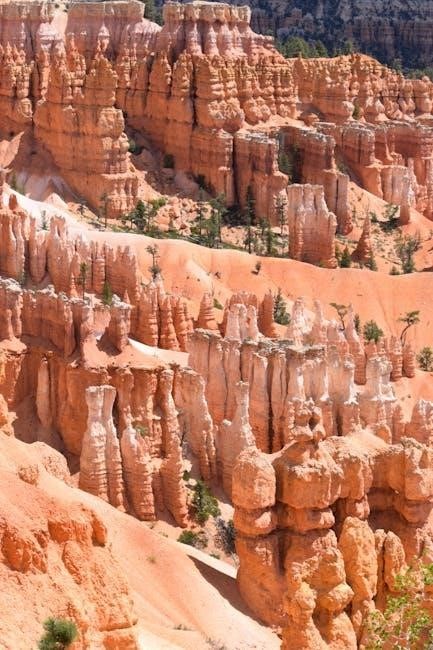
Wildlife and Vegetation in Canyons
Canyons host a variety of wildlife and vegetation adapted to harsh conditions. Unique flora includes drought-resistant plants‚ while animals like bighorn sheep and eagles thrive in these environments.
7.1 Unique Flora Found in Canyons
Canyons are home to a diverse range of unique flora‚ adapted to extreme conditions. Cacti and succulents thrive in arid environments‚ while riparian zones support willows and cottonwoods. Rare endemic species‚ like the canyon oak‚ are found only in specific regions. These plants often have deep root systems or waxy coatings to conserve water. The flora plays a crucial role in stabilizing soil and supporting local wildlife‚ creating a resilient ecosystem despite the harsh canyon climate.
7.2 Wildlife Adaptations to Canyon Environments
Canyon wildlife exhibits remarkable adaptations to survive in these harsh‚ fragmented environments. Bighorn sheep navigate steep cliffs with surefooted agility‚ while canyon wrens thrive in rocky terrain. Desert tortoises endure extreme heat with burrowing behaviors and water-efficient metabolisms. Many species‚ like rattlesnakes‚ rely on camouflage and ambush tactics to hunt and avoid predators. These adaptations enable diverse wildlife‚ including mammals‚ birds‚ and reptiles‚ to thrive in canyons‚ showcasing their resilience and ecological importance in these unique landscapes.
7.4 Birdwatching in Canyons
Canyons provide a unique habitat for diverse bird species‚ making them a paradise for birdwatchers. The steep walls and varied climates support raptors like eagles and hawks‚ as well as canyon-specialized birds such as the canyon wren. Early mornings and late afternoons are ideal for spotting these birds. Binoculars are essential for observing species in rugged terrain. With patience‚ enthusiasts can witness the vibrant feathered life that thrives in these dramatic landscapes‚ adding a thrilling dimension to canyon exploration and nature appreciation;
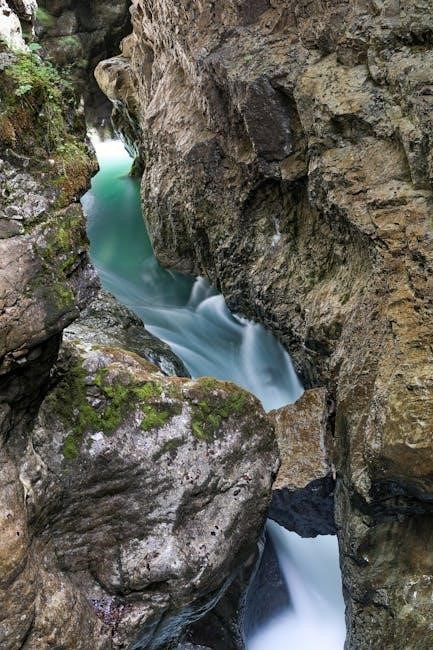
Camping in Canyons
Camping in canyons offers a unique opportunity to immerse yourself in nature’s grandeur.pitching tents in scenic spots‚ enjoying tranquility‚ and stargazing under vast‚ dark skies.
8.1 Best Campsites Near Famous Canyons
Popular campsites near iconic canyons include Mather Campground at the Grand Canyon‚ offering stunning views and proximity to trails. Zion’s Watchman Campground is another favorite‚ nestled near the Virgin River. Bryce Canyon’s Sunset Campground provides breathtaking sunset vistas. For a more remote experience‚ Fish River Canyon in Namibia offers secluded sites along the canyon rim. These locations blend convenience with unforgettable natural beauty‚ making them ideal for both casual and adventurous campers. Book early‚ as spots fill quickly during peak seasons.
8.2 Setting Up Camp in Remote Canyon Areas
Setting up camp in remote canyon areas requires careful planning and preparedness. Choose a secluded spot away from sensitive habitats‚ ensuring minimal environmental impact. Pack lightweight‚ durable gear‚ including a sturdy tent‚ sleeping bag‚ and water purification tools. Carry a first-aid kit and emergency supplies. Obtain necessary permits and follow local regulations. Practice “Leave No Trace” by properly disposing of waste and minimizing campfire use. Bring a map‚ compass‚ and GPS for navigation. Always inform someone of your itinerary before venturing into remote regions. Camping in these areas offers a serene‚ immersive experience‚ connecting you with nature’s untouched beauty.
8.3 Stargazing in Canyon Skies
Stargazing in canyon skies offers a magical experience due to the remote‚ dark environments. The vast‚ open landscapes provide unobstructed views of the night sky‚ allowing stargazers to witness the Milky Way in all its glory. Bring binoculars or a telescope to enhance the experience. Plan your visit during clear weather and new moons for optimal stargazing. The tranquility of the canyons amplifies the beauty of the stars‚ creating a truly unforgettable moment of connection with nature.
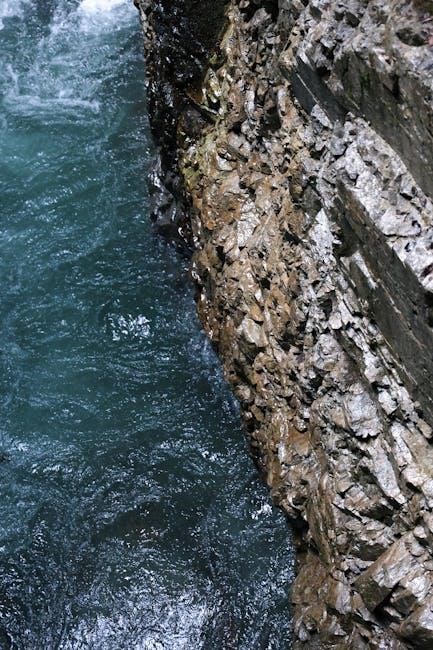
Cultural and Historical Significance
Canyons hold profound cultural and historical value‚ serving as spiritual sites for indigenous peoples and markers of ancient civilizations. They reveal stories of early human habitation and exploration.
9.1 Indigenous Peoples and Their Connection to Canyons
Indigenous peoples have deeply connected with canyons for millennia‚ often considering them sacred spiritual and cultural sites. Many Native American tribes‚ such as the Navajo and Hopi‚ believe canyons hold ancestral spirits and creation stories. These areas have provided sustenance‚ shelter‚ and inspiration‚ with petroglyphs and ruins serving as testaments to their enduring legacy. Preserving these sites honors their historical and spiritual significance‚ ensuring future generations can learn from and respect these ancient traditions.
9.2 Historical Expeditions and Explorers
Canyons have been pivotal in shaping human exploration and discovery. Explorers like John Wesley Powell famously navigated the Colorado River through the Grand Canyon in 1869‚ documenting its vastness. Such expeditions opened regions to further settlement and scientific study‚ revealing geological wonders and sparking curiosity about Earth’s history. These journeys not only expanded geographical knowledge but also inspired future adventurers‚ leaving a lasting legacy in canyon exploration and cultural understanding.
9.3 Ancient Rock Art and Ruins
Canyons are treasure troves of ancient rock art and ruins‚ offering glimpses into the lives of early civilizations. Petroglyphs and pictographs adorn canyon walls‚ depicting stories of indigenous cultures. Cliff dwellings‚ such as those in the Grand Canyon‚ reveal sophisticated architecture. These sites‚ preserved for centuries‚ provide insights into the spiritual and practical lives of ancient peoples. They are not only cultural treasures but also vital links to understanding human history and the connection between landscapes and societies.
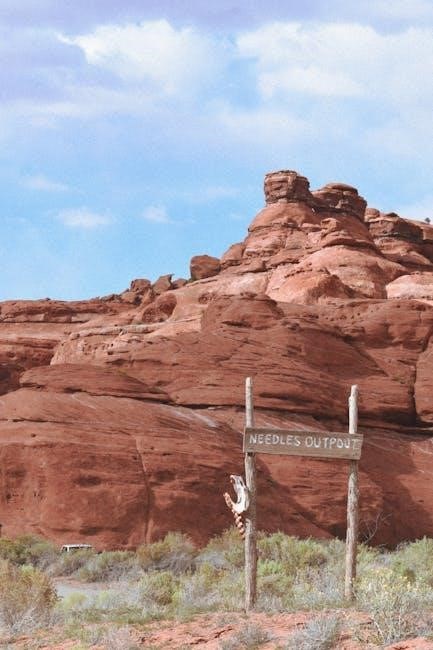
Environmental Conservation
Canyons’ fragile ecosystems require vigilant conservation efforts to protect biodiversity and natural beauty‚ ensuring these landscapes remain preserved for future generations to explore and appreciate.
10.1 Threats to Canyon Ecosystems
Canyon ecosystems face significant threats from climate change‚ pollution‚ and human activities. Rising temperatures alter water flows‚ affecting flora and fauna. Pollution degrade water quality‚ harming aquatic life. Over-tourism and invasive species disrupt native habitats‚ threatening biodiversity. Unregulated development increases erosion and soil degradation. These factors collectively jeopardize the delicate balance of canyon environments‚ emphasizing the urgent need for conservation to preserve these natural wonders.
10.2 Sustainable Tourism Practices
Implementing sustainable tourism practices is crucial for preserving canyon ecosystems. Minimize environmental impact by staying on designated trails and avoiding litter. Support eco-friendly tour operators that adhere to conservation guidelines. Reduce waste by carrying reusable containers and respecting local regulations. Promote responsible behavior by educating visitors about canyon fragility. Encourage support for local communities through ethical purchases. Adopting these practices ensures canyons remain pristine for future generations while maintaining their natural beauty and cultural significance.
10.3 Efforts to Protect Canyon Landscapes
Conservation efforts for canyon landscapes include strict regulations on development‚ habitat restoration‚ and public education campaigns. National parks and protected areas safeguard canyons from human impact. Organizations like the National Park Service and local conservation groups work tirelessly to monitor and preserve these natural wonders. Initiatives such as reforestation and wildlife conservation are implemented to maintain ecological balance. Public-private partnerships also play a crucial role in funding and executing these protective measures‚ ensuring canyons remain untouched for future generations.